|
Selected Links
Archive Index
Wooden Shells
Parts List
History
Refinishing
Who Built It
George on Rowing
"We try to give them shells that will raise their spirit a little above their competitors'."
 George Pocock's intimacy with the material properties of wood, knowledge of how it must interact with a crew and poetic nature made the Pocock name legendary. Nearly a century later, we continue to pursue the highest standard of excellence. Diligence, science and art come together in the sometimes invisible nuances that make Pocock boats unique.
The Artisan at Work: 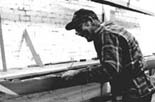 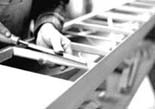 Bob Brunswick Celebrating 50 Years of Craftsmanship Bob Brunswick Celebrating 50 Years of Craftsmanship
|
Founded in America in 1911, Pocock Racing Shells has patterned nearly 100 years of rowing history.
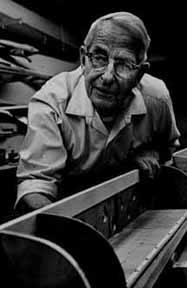 | 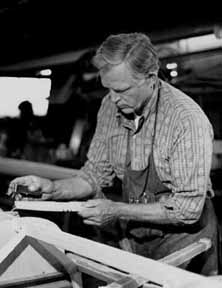 | George Pocock | Stan Pocock | GEORGE POCOCK (1891 - 1976) The Pocock family origins in boat building can be traced back to England, the cradle of shell building and racing, where George's father was the head boat builder for Eton College at Windsor around the turn of the century. As a young man, George raced single shells on the Thames. At one of these races he won £50 and with the money purchased passage for himself and his brother, Dick, on a cattle boat bound for Canada. In 1911, on George's 20th birthday, they arrived in Vancouver, British Columbia, with $20 in their pockets and a dream of building fine racing boats. They rented the Vancouver Rowing Club's boathouse, without moorage, and found that at low tide they rested precariously on the mud flats. During the ensuing year, they nearly starved. Help arrived in the midst of a winter gale when Hiram Conibear, then coach of the University of Washington racing crew, rowed out to the boathouse and coaxed both the brothers into coming to Seattle to build boats for the university. Ecstatic, they cabled their father to join them and left for Seattle. Their dream faded quickly, however, when the university gave them and old lakeside tea room, without heat or lights, for a shop, and ordered one 8-man shell. By 1916 they were again in despair when a distinguished-looking man walked into their shop and, after examining their work, left his business card. Within a few days they were building float plane pontoons for William E. Boeing's new airplane company. George eventually became foreman of the assembly department, Dick became boat-builder for Yale University, and their father returned to England. In 1922 a new University of Washington coach planted a story in the Seattle Post-Intelligencer on the sports page that George had agreed to return to the university. It was just the prodding that George needed to return to his real love, boat-building. In the following year, 1923, the unknown University of Washington rowing team went east and won the national championship in a George Pocock boat. Thus began the legend of George Pocock Racing Shells. For the next 50 years George Pocock, with care and grace, built racing shells for nearly every racing college in the country and several abroad. His reputation spread as he strove to maintain the highest possible quality at a price that even small colleges or high schools could afford. His boats went on to win many national and Olympic championships. Upon George Pocock's death in 1976, the Lake Union based company was taken over by George's son, Stanley. 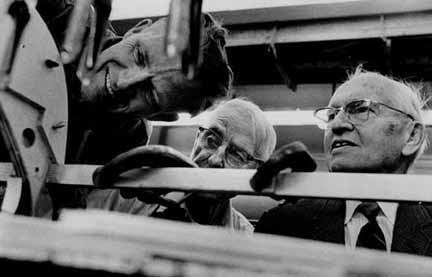 Royal Brougham, Seattle Post Intelligencer Sports Writer, looks into business with George and Stan. STANLEY POCOCK When Stan Pocock was a young man, he followed the tradition and apprenticed with his father, George. Stan grew up in Seattle, was an oarsman at the University of Washington, graduated in Engineering and became the very successful and popular coach of the University's Lightweight and Freshman Crews. In later years, management of the company became Stan's responsibility while George devoted himself to constructing cedar single shells. Stan was to prove himself not only as a "natural" in boatbuilding, but also in coaching. In addition to coaching at the University 1947 through 1955, he was the first coach for Lake Washington Rowing Club upon its formation in 1958, and coached several gold medal winning crews in the 1956 and 1960 Olympic Games. "Rowing isn't easy," Stan says about the sport. "It's so much a matter of heart. The oarsman must be sold on what he's doing and so enthusiastic about it that the hurt doesn't matter. Technique and conditioning are things that every oarsman has... so they become relatively unimportant. "We know that men respond to rowing in a beautiful piece of equipment, and we try to give them shells that will raise their spirit a little above their competitors'." Times were changing and it was Stan who carried the company from it's Dickensian past into the modern age. In fact, it was only when his father was away at the 1956 Olympics in Australia (a 2 month voyage via Steamer) that he was really able to experiment with fiberglass. He replaced the wood ribs with a fiberglass sandwich skin, which was quite an extraordinary innovation for 1956! In 1961 Stan made the first fiberglass rowing boat ever- a wherry. A few years later he developed the fiberglass training single, many of which are still happily rowed. Ever the innovator, Stan took every opportunity to introduce new methods and materials to rowing. By 1970 he was running the shop and tinkering with ideas that were ahead of their time. He was first in many areas, including the development of a successful wood and glass laminated composite oar, molded seat tops, and adjustable oarlock height spacers. Impressed with innovations in composite engineering from aerospace industries, and adding his own experience to that of the Boeing engineers, he developed the first line of all carbon fiber monocoque racing shells in 1981. One of those shells is still rowed at the University of Washington. The development of the indefatigueable shoulderless boat was his crowning achievement. WILLIAM TYTUS Stanley sold the business to long time family friend William Tytus in 1985. The relationship began when Bill, who was just a boy riding his bicycle past the Conibear shop on the shores of Lake Washington, had the temerity to stop and inquire as to the goings on inside. He became a frequent visitor to the shop, forged a lifelong friendship with the Pocock family, and unwittingly initiated a career that has carried Pocock Racing Shells forward into the next millennium. Bill is singularly focused on making the stiffest and best possible boats. With a federal grant for the research and development of light composite structures, and a lot of in house experimentation with resins, paints, laminating fabrics and materials, he is certain of the superiority of Pocock's precedence setting shells. "What most people don't understand," he says, "is that it is a long process. The design and construction of racing shells is continually refined throughout many years of experience, and all of these threads are coming together in better products." Pocock Racing Shells is today's industry leader. After a series of studies with flex testing, and while experimenting with the newest fibers, everything from the rigger configuration to the laminate schedule was changed in 1986; thus perfecting Stan's initial concept of the shoulderless boat. While these breakthroughs have often been imitated, they have yet to be matched. Comparative testing of the redesigned shells shows that Pocock shells are the stiffest and lightest on the market. The Pocock design path of the 90's is in reducing wavemaking drag without sacrificing other qualities. The proven success of the K Four at the 1996 Olympic Games has lead to larger leaps forward along this developmental path, with many completely new shells being introduced. Visit our Engineering to learn more about the latest developments at Pocock Racing Shells. |







